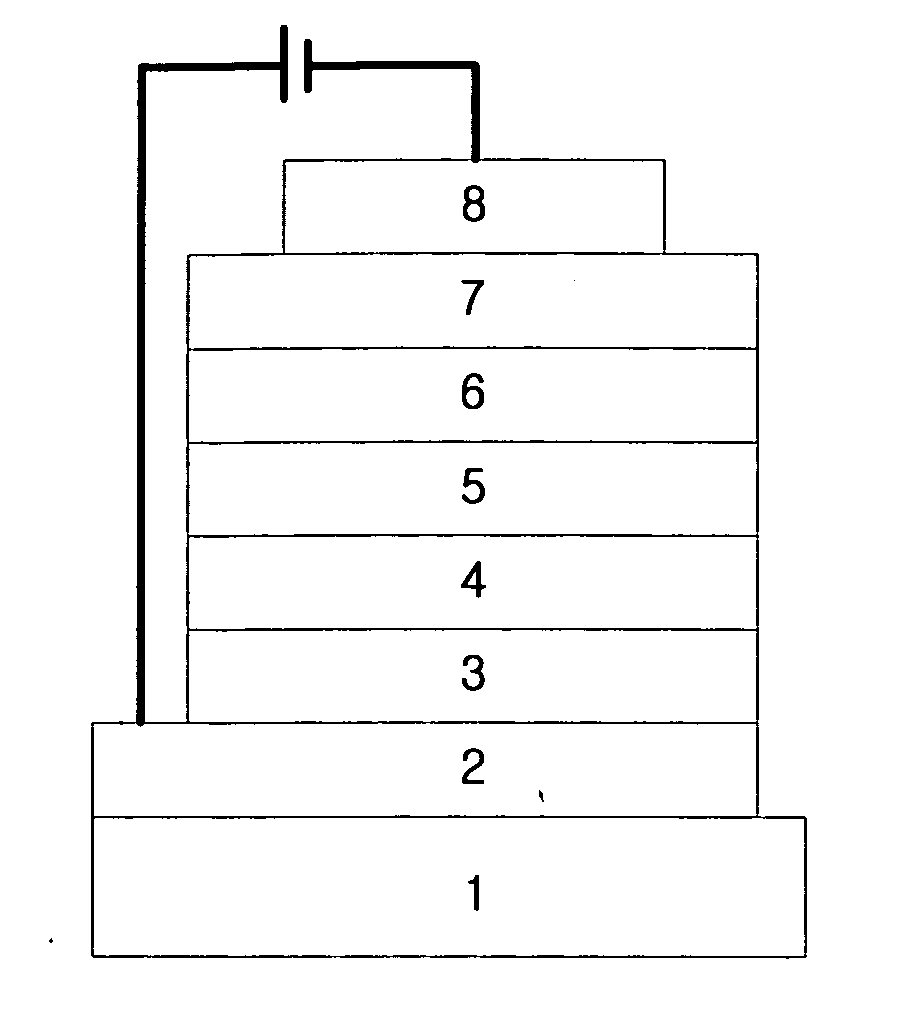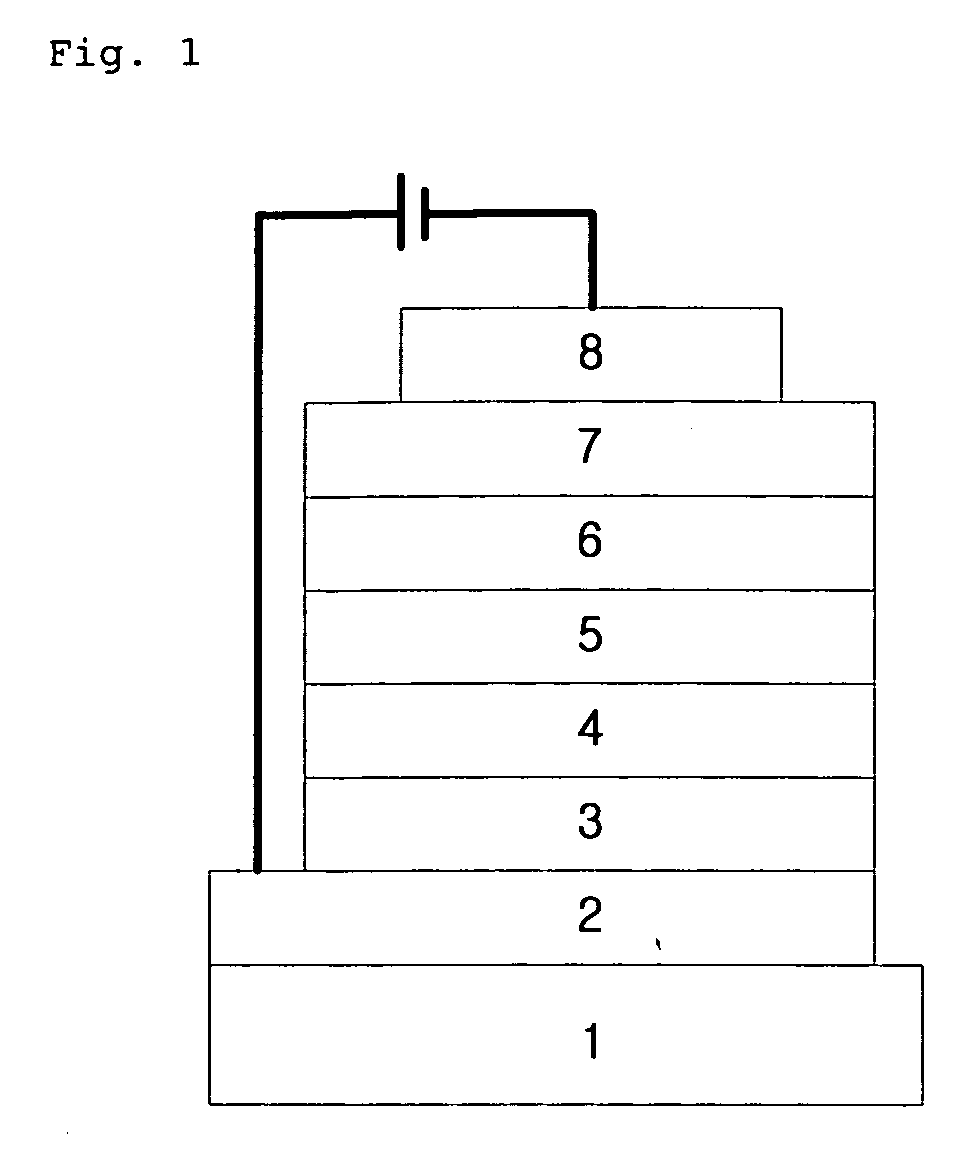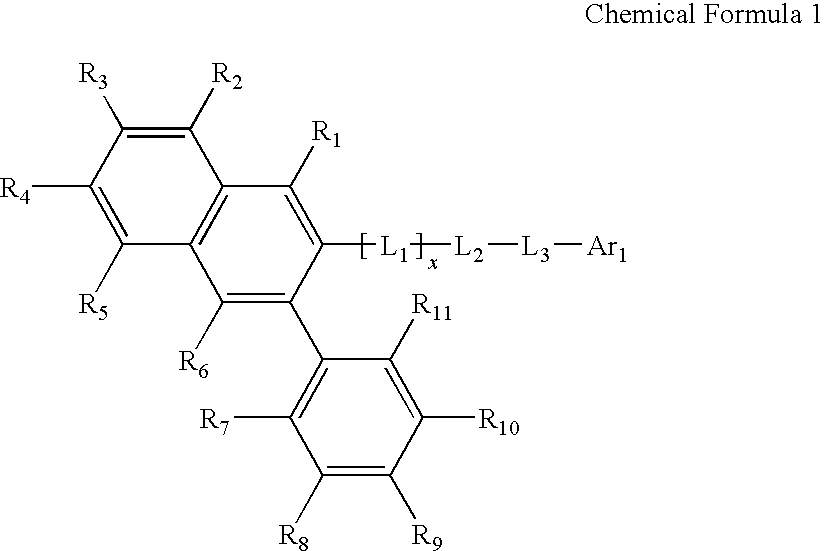Novel organic electroluminescent compounds and organic electroluminescent device using the same
- Summary
- Abstract
- Description
- Claims
- Application Information
AI Technical Summary
Benefits of technology
Problems solved by technology
Method used
Image
Examples
preparation examples
Preparation Example 1
Preparation of Compound (2)
[0109]
[0110]Preparation of Compound (A)
[0111]To tetrahydrofuran (THF) (670 mL), added were 2-bromobenzaldehyde (25.0 g, 140 mmol), phenylacetylene (17.8 mL, 162 mmol), dichlorobis(triphenylphosphine)palladium (II) [PdCl2 (PPh3)2] (2.8 g, 4 mmol) and cuprous iodide [CuI] (1.3 g, 7 mmol) and triethylamine (38 mL, 270 mmol) under nitrogen atmosphere, and the mixture was stirred under reflux at 80° C. for 3 hours. The reaction mixture was washed with distilled water and ethyl acetate, and purified via column chromatography to obtain Compound (A) (16.0 g, 78 mmol).
[0112]Preparation of Compound (B)
[0113]Phenylacetylene (32.3 mL, 294 mmol), NBS (N-bromo succinimide) (58 g, 323 mmol) and silver nitrate (AgNO3) (5.0 g, 30 mmol) were added to acetone under nitrogen atmosphere, and the mixture was stirred at 0° C. When the reaction was completed, n-hexane was added thereto, and the mixture was filtered. The solid obtained was washed four times wi...
preparation example 2
Preparation of Compound (360)
[0125]
[0126]Preparation of Compound (H)
[0127]Trifluoromethanesulfonic acid (29.5 mL, 0.33 mol) was slowly added to 9,10-phenanethrenequinone (7 g, 0.0336 mol) at 0° C. While maintaining the temperature at 0° C., NBS (13.2 g, 0.0742 mol) was slowly added thereto. Then the reaction mixture was warmed to ambient temperature, and stirred for 6 hours. Then the mixture was slowly poured into ice water, and filtered under reduced pressure. Washing with water and methanol gave Compound (H) (10 g, 81%).
[0128]Preparation of Compound (I)
[0129]In THF, dissolved was 2-bromonaphthalene (16.9 g, 0.0819 mol), and the solution was chilled to −78° C. To the solution, slowly added was n-BuLi (2.5 M in hexane) (28 mL). After 30 minutes, the mixture was warmed to ambient temperature, and stirred for additional 30 minutes. Compound (H) (10 g, 0.0273 mol) was added at once, and the mixture was stirred at ambient temperature for 12 hours. After extracting with ethyl acetate / dis...
preparation example 3
Preparation of Compound (794)
[0135]
[0136]Under nitrogen atmosphere, 9,10-dibromoanthracene (4.6 g, 12 mmol), Compound (D) (4.8 g, 14 mmol), 2M potassium carbonate solution (18 mL) and tetrakis(triphenylphosphine)palladium [Pd(PPh3)4] (0.7 g, 0.6 mmol) were added to toluene (100 mL), and Aliquat 336 (0.1 mL) was added thereto. The resultant mixture was stirred under reflux at 80° C. for 12 hours. The compound thus obtained was washed with distilled water and ethyl acetate, and purified via column chromatography to obtain Compound (794) (3.2 g, 5.5 mmol).
[0137]According to the same procedure as Preparation Examples 1 to 3, organic electroluminescent compounds (Compounds 1 to 939) were prepared, of which the 1H NMR and MS / FAB data are shown in Table 1.
TABLE 1MS / FABComp.1H NMR (CDCl3, 200 MHz)foundcalculated1δ = 7.41 (2H, m), 7.51~7.52 (6H, m), 7.59 (2H,456.58456.19m), 7.71 (2H, m), 7.79 (2H, m), 8 (2H, m),8.1 (2H, m), 8.34 (2H, m), 8.4 (2H, m),8.99 (2H, m)2δ = 7.41 (1H, m), 7.51~7.61 (...
PUM
| Property | Measurement | Unit |
|---|---|---|
| Length | aaaaa | aaaaa |
| Length | aaaaa | aaaaa |
| Length | aaaaa | aaaaa |
Abstract
Description
Claims
Application Information
 Login to View More
Login to View More - R&D
- Intellectual Property
- Life Sciences
- Materials
- Tech Scout
- Unparalleled Data Quality
- Higher Quality Content
- 60% Fewer Hallucinations
Browse by: Latest US Patents, China's latest patents, Technical Efficacy Thesaurus, Application Domain, Technology Topic, Popular Technical Reports.
© 2025 PatSnap. All rights reserved.Legal|Privacy policy|Modern Slavery Act Transparency Statement|Sitemap|About US| Contact US: help@patsnap.com



